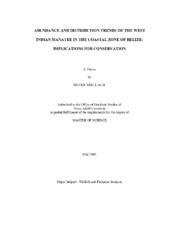| dc.description.abstract | The coastal zone of Belize is home to the largest recorded number of the threatened Antillean manatee (Trichechus manatus manatus) within the species' Caribbean range. The objectives of my study were: (1) to determine long-term trends in aerial survey counts and indices of the manatee population in the coastal zone of Belize; and (2) to examine the seasonal change in manatee distribution among habitats in the coastal zone. Standardized extended-area aerial surveys were conducted along the entire coastline of Belize in the dry and wet seasons of 1997, and 1999 - 2002. Manatees were counted in five habitat categories: cay, coast, estuary, lagoon, and river. Total sightings per survey ranged from 90 to 338; the greatest number was counted in the 2002 wet season. Calf percentage ranged from 5 to 13. A slight negative trend in total counts was significant for dry-season, not wet-season surveys, indicating an interactive effect of season and year. Based on analysis of variance, the Abundance Index (transformed manatee sightings per hour) did not differ significantly among years, although it varied significantly within year by season and habitat by season. In applying a spatial approach, the general survey route was buffered 1 km on both sides, and 1 km grids were overlaid and classified by habitat type. The presence or absence of each cell for each survey was used in likelihood ratio tests of the single and interactive effect of season and habitat. The Index for river habitat was higher in the dry season, while cay habitat was higher in the wet season. Overall, near-shore habitat (estuary, lagoon, and river) showed a higher Index than did the offshore habitat (cay and coast) although the total number of sightings was higher offshore. Considering the interactive effect of year, season, and habitat, long-term studies are needed, in both seasons, and among all habitats to account for variation. Continued broad-scale surveys, along with metapopulation analysis would fine-tune the understanding of specific sites, enhancing integrated coastal zone management for protected species and their habitat systems. | en |


